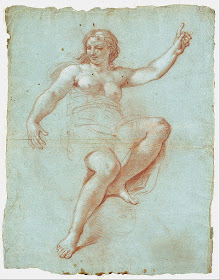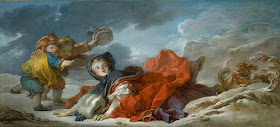 |
| Aelbert Cuyp River landscape with riders ca. 1653-57 oil on canvas Rijksmuseum, Amsterdam |
 |
| Aelbert Cuyp Page with two horses ca. 1655-60 oil on canvas Royal Collection, Windsor |
 |
| Aelbert Cuyp Cows in a river ca. 1650 oil on panel Museum of Fine Arts, Budapest |
"Gravy-colored" landscapes from the 17th century by "Dutch masters" were often mocked in 19th-century England, but mocked because of their extreme popularity. It seemed incongruous at the time, and still does, that a coterie of sophisticated and even extravagant aristocrats led by the Prince Regent should pour their sincerest emotions and large reserves of cash into acquiring these small brown pictures. Work by Aelbert Cuyp (1630-1691) in particular was of such desirability that several paintings purchased as his for the Royal Collection at Windsor were later found to be painted by other hands.
 |
| follower of Aelbert Cuyp Cattle near a river 17th century oil on canvas Dulwich Picture Gallery, London |
 |
| Aelbert Cuyp The Valkhof at Nijmegen ca. 1652-53 oil on panel Indianapolis Museum of Art |
 |
| Aelbert Cuyp Herdsmen with cows 1645 oil on canvas Dulwich Picture Gallery, London |
 |
| Aelbert Cuyp Two Cavalry Troopers talking to a peasant ca. 1650 oil on panel Royal Collection, Windsor |
 |
| Aelbert Cuyp Cavalry Trooper decorating a dappled-gray horse ca. 1652 oil on canvas Royal Collection, Windsor |
 |
| Aelbert Cuyp River landscape with riders ca. 1653-57 oil on canvas Rijksmuseum, Amsterdam |
 |
| Aelbert Cuyp The Passage Boat ca. 1650 oil on canvas Royal Collection, Windsor |
 |
| Aelbert Cuyp Road near a river ca. 1660 oil on canvas Dulwich Picture Gallery, London |
 |
| Aelbert and Jacob Cuyp Portrait of a family in a landscape 1641 oil on canvas Israel Museum, Jerusalem |
 |
| Aelbert Cuyp Portrait of the Sam family ca. 1653 oil on canvas Museum of Fine Arts, Budapest |
 |
| Aelbert Cuyp Portait of a young officer ca. 1640-60 oil on panel Rijksmuseum, Amsterdam |










































